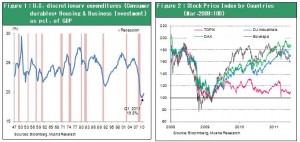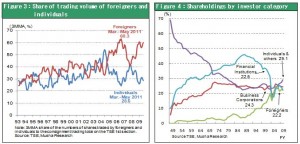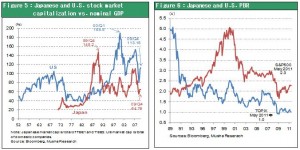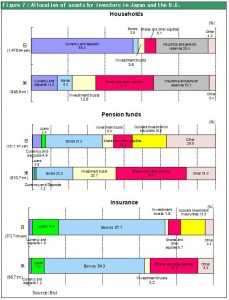The summer rally has started
Stock prices in the United States are surprisingly strong. Last week, the S&P 500 index rose 5.6% and the Dow Jones Industrial Average surged 5.4%. This is the biggest one-week rally over the past two years. Stock prices that rise in tandem with a reversal to an upturn in long-term interest rates may signal the end of the two-month period of risk-off trading. If we use the gap between earnings yields and real long-term interest rates as the risk premium, then U.S. stocks too are clearly undervalued (but not as much as Japanese stocks). Furthermore, Greece is no longer a critical risk factor for the market at this point that the country has approved a fiscal austerity package and received the next tranche of its bail-out loan.
The U.S. economy may be early stage of long term expansion
The end of the current soft patch of the U.S. economy is in sight. The U.S. manufacturing sector is starting to improve as progress continues in Japan with restoring supply chains following the Great East Japan Earthquake. Right now, the U.S. economy is like an accordion that is pressed all the way in. No more room for compression remains. As Figure 1 shows, discretionary expenditures (expenditures that can be put off for the time being) have fallen to an all-time low as a percentage of the U.S. GDP. When consumer sentiment becomes extremely negative, people buy only what is needed to meet their immediate needs. But if consumers become more confident, their purchases will shift to durable, long-term goods as buying migrates from food and clothing to home appliances, automobiles, furniture and homes. This shift will occur at companies, too. Instead of making only the smallest possible investments needed for maintenance and repairs, companies will start making long-term commitments by increasing output, entering new markets and M&As. As these purchases and investments with a long-term perspective grows so will the depth of demand. However, the United States is currently in the midst of an unprecedented short-term focus that is keeping demand extremely thin. This situation clearly shows that the United States has stored up energy that can fuel economic growth.
Earthquake reconstruction will spark a catch-up stock market rally in Japan
Both Japanese stocks and investors have been conspicuous for their lack of vitality. Japan’s stock markets stand alone as the only loser in the world. Global stock markets staged a powerful rally that doubled stock prices after prices hit bottom following the Lehman shock. But Japan’s TOPIX is up only 20% and the Nikkei Average bounced back only 40%. Japan suffered two severe blows after the wake of the Lehman shock. First was the reemergence of deflation caused by the extreme strength of the yen. Second was the impact of the March earthquake and tsunami. But an enormous reversal may occur starting in the second half of 2011 in these two factors that have held back Japanese stocks. If this happens, these reversals will most likely trigger a catch-up rally in Japan’s stock markets.

The lack of vitality among Japanese stocks and investors
Foreigners hold only about 20% of Japanese stocks but account for 60% of trading volume on Japan’s stock markets. This disparity clearly indicates the low level of interest in stocks among Japanese investors. Furthermore, Japanese institutions like pension funds and life insurers continue to reduce Japanese stocks as a percentage of their portfolios. Figure 7 shows how Japanese investors’ equity holding as a percentage of the portfolios is low compare with that of the U.S. investors. As you can see, this percentage has decreased even though it was already extremely low. What is the explanation for this strange situation? First, Japanese investors are still clinging to habits shaped by after-shocks from past mistakes and the resulting aversion to risk. Second, investors’ activities are restricted by the tendency of following the crowd and by numerous regulations. From the standpoint of the unusually strong negative bias of Japanese markets, last week’s U.S. stock market rally can even be viewed as a mystifying event. But the Bank of Japan Tankan and industrial output forecast along with auto-manufactures production plan show that the rebound in Japan’s manufacturing sector following the earthquake is remarkably strong. Japan is obviously playing a leading role in ending the economy’s current soft patch.
A correction of today’s unusual valuations is inevitable
The difference between the 7% yield of Japanese stocks and 1% long-term interest rate results in a premium of 6 percentage points. A premium of this magnitude is extremely unusual even in comparison with historic premiums in other countries and shows that Japanese stocks are clearly under-valued . We can view this 6% premium as a “price decline reserve.” Prices of Japanese stocks have dropped by two-thirds over the past 20 years. This translates into an annual decline of 5%, so investors have been buying stocks at prices that factor in this 5% downturn. But if stocks have fallen to a point where they cannot go any lower, this 5% “price decline reserve” will instead become extra profit on investments. This is why investors worldwide, who have been shunning Japanese stocks for so many years, will sooner or later almost certainly rush to buy these stocks.

Figures 5 and 6 show stock market capitalization as a percentage of GDP and the price-to-book ratios of stocks in the United States and Japan. These figures are further evidence of how far Japanese stocks have lagged behind the stocks of other countries. Everything is in place for a catch-up rally in Japanese stocks not only in the near term but from a medium and long-term standpoint as well.



 Figures 5 and 6 show stock market capitalization as a percentage of GDP and the price-to-book ratios of stocks in the United States and Japan. These figures are further evidence of how far Japanese stocks have lagged behind the stocks of other countries. Everything is in place for a catch-up rally in Japanese stocks not only in the near term but from a medium and long-term standpoint as well.
Figures 5 and 6 show stock market capitalization as a percentage of GDP and the price-to-book ratios of stocks in the United States and Japan. These figures are further evidence of how far Japanese stocks have lagged behind the stocks of other countries. Everything is in place for a catch-up rally in Japanese stocks not only in the near term but from a medium and long-term standpoint as well.



